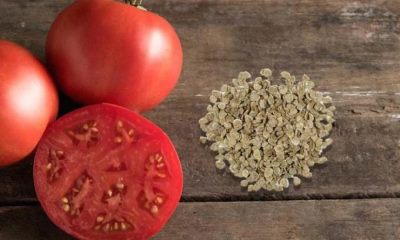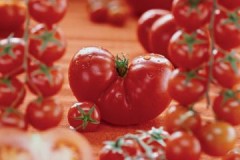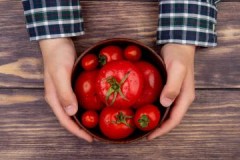Advice from gardeners on how and how long to store tomato seeds
 Tomatoes in a summer cottage can be grown from seeds.
Tomatoes in a summer cottage can be grown from seeds.
In order for good germination to occur, the seed must be stored correctly.
We will tell you in this article how and for how long you can store tomato seeds at home.
Content
Deadlines
Several different factors influence the shelf life of seeds. One of them is the type of packaging.
In cases where seeds are purchased in a specialized store, it is necessary to check on the packaging what the expiration date is on them. Usually for products in paper bags the shelf life is one year, in foil packaging – up to 2 years.
If seeds are purchased in plastic bags, they must be placed in paper packaging to ensure air exchange.
Rules
 The future germination of seeds directly depends on compliance with storage conditions.
The future germination of seeds directly depends on compliance with storage conditions.
The temperature in the place where the planting material is kept should not be high: +6-12°С, maximum is +15°С.
Humidity should be around 55%. Another important point is protection from light (both natural and artificial).
Storage at home
If you use seeds collected yourself at your dacha, this can not only be financially beneficial, but also give you confidence in the final result.But this method also has its own characteristics, which begin at the stage of collecting future seed material.
Collection, preparation, laying
In order to collect seeds that will not create surprises when planted, A number of points need to be taken into account:
- It is not recommended to collect seed from hybrids, since in this case the result will not be predictable.
- It is advisable to choose varietal tomatoes, large and ripe, without defects.
- It is recommended to collect material from fruits that are among the first to ripen.
- Overripe tomatoes are not suitable for collecting seeds. The best option is a little unripe, but already has the color of a ripe fruit.
- It is advisable to pick tomatoes from the first bunch (for those planted in the ground) or from the second (for greenhouses).
- The bushes from which fruits are collected to obtain seeds must be healthy.
The selected vegetable is cut in half lengthwise and seeds are selected from it. In order to remove the pulp, they are placed in water. After the seeds have been separated, the material must be dried.
The video will tell you about collecting tomato seeds for subsequent storage:
Where can and cannot be kept?
For storing seeds, a place can be selected that maintains suitable conditions for them. It could be:
- fridge,
- cool veranda,
- pantry, etc.
Selection of containers
If a lot of seeds are being prepared, then the best container for keeping them will be glass jars with lids. You can also use thick paper bags (envelopes).
So as not to confuse anything, It is important to sign each package - mark the name of the variety on it and indicate the date of preparation.
Is it worth planting expired ones?
Seeds that have been stored for many years should first be checked for germination before planting. This will give an understanding of what results can be expected in the future.
Germination test
The germination test is carried out as follows:
 Prepare a flat container (for example, a saucer) and a thin cotton cloth.
Prepare a flat container (for example, a saucer) and a thin cotton cloth.- Fold the fabric (or napkin) several times and place it in a saucer.
- Moisten the fabric.
- Place the seeds between layers of material.
- Place the saucer in a plastic bag to maintain a moist environment.
- Place the saucer in a warm place (at +25°C).
- Periodically you need to check whether the fabric is drying out. If necessary, add water.
- After 4-5 days, the seeds can be checked for germination. The number of germinated ones should be more than 50%.
Germination stimulants
If the seeds showed poor germination when tested, but it is very necessary to save the seed and put it into use, you can use so-called growth stimulants.
These products include:
- aloe juice;
- ash;
- succinic acid.
Another possible method of exposure is soaking in a solution of hydrogen peroxide. For processing you will need:
- 90 ml water;
- 10 ml of 3% hydrogen peroxide from the pharmacy.
Procedure:
- Before planting seeds in the ground, they need to be placed in a solution prepared from peroxide and water. There should not be a lot of liquid; not even complete coverage of the planting material is enough.
- Leave for 2 or 3 days, or more if the seeds are very old.
- After germination of the sprouts, plant.
The more stale material is used, the longer it will take until sprouts emerge from the seeds.
Special growth stimulants
 Ready-made solutions can also be used to stimulate growth, which are purchased in specialized stores.
Ready-made solutions can also be used to stimulate growth, which are purchased in specialized stores.
Among them:
- "Epin";
- "Ekopin";
- "Zircon", etc.
It is very easy to use such drugs. To do this you need to perform the following sequence of actions:
- Place the seeds in water.
- Prepare a solution of 100 ml of water and 1 ml of the selected product.
- Dip the seeds into the prepared solution.
- Leave for 6-8 hours.
Video on the topic of the article
This video will tell you about storing tomato seeds:
Conclusion
Storing tomato seeds will not be difficult if done correctly. All circumstances are important - from the choice of fruit for collecting seed material to the organization of conditions at the place of detention.


